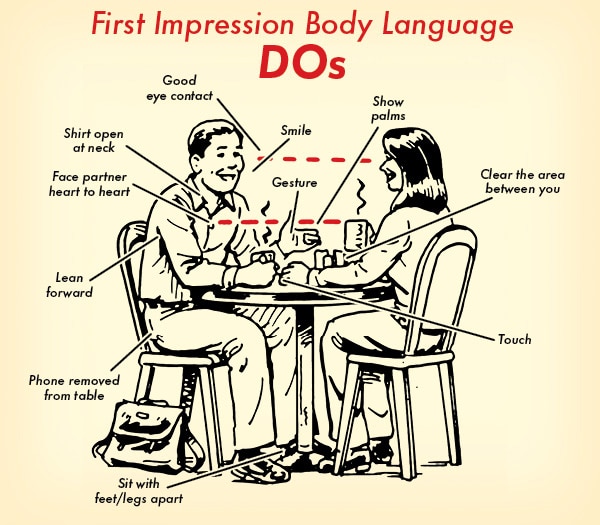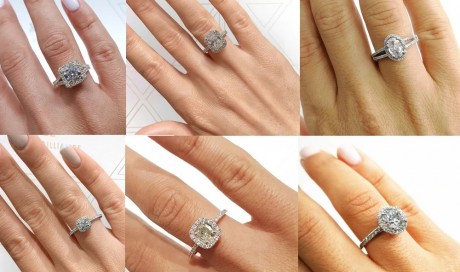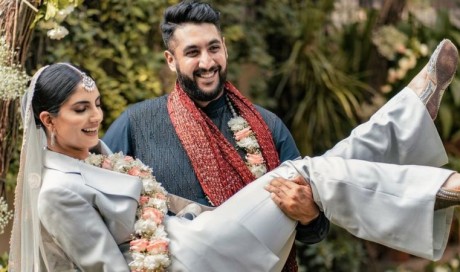
Body Language That Communicates Interest
There’s probably not a truer truism of making a good first impression than the fact that people like people who are interested in them. Why is this the case? Because interest invariably becomes reciprocal. As Wood explains:
Interest cannot only be conveyed by asking someone plenty of open-ended questions and listening attentively while they talk, but also by the kind of body language you exhibit. In some instances your behaviors will be a continuation of what you started in order to convey openness, but now have an added layer of meaning in the context of interacting.
Continue smiling. Frequent smiles show that you’re enjoying the conversation and the person’s company.
Nod. Men tend to be stingy with their nods, worrying that the gesture indicates they’re agreeing with what’s being said. Yet nodding doesn’t have to mean “Yes, I agree” but simply “Yes, I’m listening.”
Lean in. Leaning shows that you are listening attentively, and that you want to be literally and metaphorically closer to the person you’re talking to. You needn’t spend an entire dinner at the edge of your seat, however; lean back when the conversation moves through lighter lulls, and forward when the discussion dips into heavier and more personal topics.
Make ample eye contact. “Think of eye-to-eye contact as a battery charger,” Wood says. “Unless you plug into the other person, there is no charge between you.” Simply making lots of eye contact isn’t effective, however, and can actually backfire if you do it wrong. People don’t want to be stared at constantly; that creates discomfort. Rather, aim to make eye contact about 60% of the time during a conversation, looking away or down at their mouth about every 5 seconds or so. Here’s much more on how to do eye contact the right way.
Face your partner straight on (especially if they’re a lady). Remember the importance of talking “heart to heart”? Continue to orient yourself so that you’re directly facing the person you’re talking with. This strengthens your connection, and facilitates greater eye contact. This is especially important when you’re talking to a woman; if you’re talking to a man, they may prefer to converse side-by-side. Eye contact between men is less important, and the side-by-side stance can feel less confrontational.
Don’t extend your leg. One of the behaviors that most registers as disinterest is sticking your leg out straight in front of you when you’re seated. Perhaps because it seems to set up a barrier, or push the other person away.
Touch. In a study in which half the patrons returning a book to the library were touched by the librarian for a mere half-second, and half were not, those touched reported liking the librarian, and the library, better than the control group. The touched group also reported being in a better mood overall.
Touch creates an instant connection, and good feelings of warmth and intimacy. It tells the touched person they’re attractive and appealing — physically, emotionally, and/or spiritually. And it brings a certain chemistry to encounters.
This is obviously beneficial in potentially romantic interactions. Without that spark, a date can feel like a tepid meeting between platonic acquaintances. First touches — brushed fingers, the hand offered for help out the car, knees touched together in the theater — builds excitement and bespeaks the potential for more intimacy and a deeper relationship.
But touch can be employed beneficially in non-romantic settings as well — even between those of the same sex, and even in the workplace. Obviously in a time of heightened sensitivity to sexual harassment, one has to tread carefully and adapt their touches to the professional context. These touches aren’t sexual, per se, they’re simply reminders that we’re physical beings — flesh and blood humans and not just corporate drones. Light, friendly, affirmative touches like a handshake, a pat on the back, a hand on the shoulder, or even just a tap to get someone’s attention or direct it somewhere else, can build a warmer bond between colleagues.
Keep watching those feet…Feet that migrate towards the door not only show nervousness, but can also indicate a lack of interest. Keep them pointing towards your partner.
…and your crossed arms too. Remember that study where participants who listened to a lecture with their arms crossed felt more negative and stressed? Well they also retained almost 40% less of the information presented. Putting yourself in that kind of defensive posture causes you to lose interest in what someone’s saying.
By employing these body language techniques you can comport yourself in a manner that best highlights your personality and character, and makes the real you more accessible and attractive to others. Practicing good body language helps you get out of your own way when making a first impression, so that you can better connect with the new people you meet each and every day.
Share This Post














